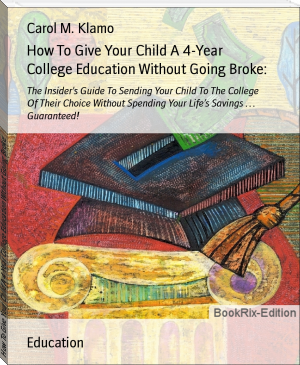How To Give Your Child A 4-Year College Education Without Going Broke: - Carol M. Klamo (top novels to read txt) 📗

- Author: Carol M. Klamo
Book online «How To Give Your Child A 4-Year College Education Without Going Broke: - Carol M. Klamo (top novels to read txt) 📗». Author Carol M. Klamo
Chapter #9
“How To Appeal For The Best Deal On A College Education For Your Child...”
In this chapter, we’re going to discuss an extremely important topic - one that will significantly impact both your child and your bank account.
I’m talking about...
How To Appeal For The Best Deal On A College Education!
Most parents take this subject lightly, and figure whatever the schools end up offering them is the best that they will get.
Let me tell you something...
Nothing Could Be Further From The Truth!
Let me ask you a question...when you went to purchase or lease your car - did you accept the first offer they made you, or did you look at their price as a “starting point” for negotiation?
What about when you bought your home? Did you purchase it at list price, or did you muster up all of your negotiating skills to try to get the seller to come down in price?
So why is college any different?
Even the cheapest state schools today will cost you about $18,000 between tuition, fees, books, room and board, and miscellaneous expenses.
A private university can easily cost you $34,000 a year and up.
Now multiply those amounts by 4. Wow!!! And that doesn’t even include graduate school (God forbid!).
Are you starting to get my point yet?
A college education for your child (or children) is one of the single biggest investments you will ever make in your entire lifetime!
Doesn’t it make sense to treat it like any other major purchase, and do your best to negotiate the best possible financial aid package for your child?
So Where Do You Begin?
Well, for starters, your children should be doing their best to get good grades in school. In addition, they should be taking some type of review course to get a good score on their SAT’s/ACT’s (it’s a little late for seniors, but not for juniors).
Second, you must start narrowing down your school choices to colleges and universities where your child lies in the top 25% of the applicant pool - this will significantly increase your chances of getting a good financial aid package.
Next, you must start researching schools that have the best policies on giving good financial aid packages. You want your child to apply to schools that will meet most or all of your family’s financial need. It is also important to pick schools that have a history of giving more FREE money, less loans.
Hint - Pick schools that are well endowed and have a lot of money to give out to students. Private schools tend to have far more money available than state schools do. I recommend picking a couple of state schools as “safety” schools and the rest should be well-endowed private schools.
Fourth, you must apply to, at least, 6 - 8 schools to insure that your child gets a good offer from 1 or 2 of them. If all the schools are the same academic caliber, and some give you a good financial aid package while others give you poor packages - it will allow you to pit one college against the other when negotiating for a better financial aid package. Schools of equal caliber will often times compete for the same student by offering aggressive financial aid packages. Be sure to take advantage of this.
Lastly, you must know your numbers in advance.
For example, do you know what your “Expected Family Contribution” is?
It is the minimum amount that the government expects you to pay towards ANY school. By the way, every December the Federal Government updates the financial aid formula. This update may cause a difference in your “EFC” each year.
Schools determine what they are going to offer you by subtracting your Family Contribution from their “Cost of Attendance”.
This provides them with your family’s “Financial Need”.
Frequently, schools will offer parents far less than what they were eligible to receive. Most families don’t dispute this since they have no idea of what they should have been offered in the first place.
Don’t Let This Happen To You!
Know your numbers in advance.
Find out what your Expected Family Contribution is. Then, find out what the cost of attendance is at each school.
Make sure the schools include all costs such as tuition, fees, books, room and board, living expenses, transportation, and miscellaneous expenses.
Once you get these two numbers, calculate your financial need at each school, and make sure their financial aid packages meets most or all of your need.
If they don’t, call or write the school to discuss why they “left you short”, and try to create a subtle competition with other schools your child applied to.
If you follow these steps, you should have no problem getting a great package from, at least, 2 or 3 of the schools your child applied to.
Chapter #10
WARNING!!!
“Failure To Take Advantage Of The
New Tax Breaks Under
The Current Tax Code Could Be Hazardous To Your Wealth!”
Here’s Your Quick Start Guide To
The Educational Benefits Of The Current Tax Law...
The Federal Government is constantly updating and changing the tax laws with regards to financial aid.
And like many tax bills, these changes make a horribly complicated situation even more complex!
The latest reform filled the tax laws with loopholes, pitfalls, financial minefields, and hundreds of pages of tax code to go along with it that it’s so confusing it might as well be in another language!
First though, the good news. There are various benefits, for those who qualify, available for families paying college expenses.
Below are some of the most common educational tax benefits you should be aware of:
• 529 Savings Plans
Section 529 Savings plans are federal tax-exempt college savings vehicles that allow participants to save money in a special college savings account on behalf of a designated beneficiary qualified higher education expenses. Most states exempt earnings from state income tax, and some states allow families to deduct the full or partial amount of their contribution from their state income taxes.
The Section 529 Savings Plan is treated as an asset of the account owner, not the beneficiary. If the parent owns the Section 529 Savings Plan the value is included in the EFC. If grandparents own the Section 529 Savings Plan, none of the value is included. A Section 529 Savings Plan owned by a dependent student, or by a trust or custodian for the student, is counted as an asset of the parent.
• 529 Prepaid Tuition Plans
Section 529 Tuition Prepayment plans will no longer be treated as an available student resource in the Federal needs analysis formula when determining eligibility for financial aid. Now, under the Higher Education Reconciliation Act of 2005, they will be treated the same as a Section 529 Savings Plan. Most states exempt earning from state income tax, and some states allow families to deduct the full or a partial amount of their contribution from their state income taxes.
The Section 529 Tuition Prepayment Plan is treated as an asset of the account owner, not the beneficiary. If a parent owns the Section 529 Tuition Prepayment Plan the value is included in the EFC. If grandparents own the Section 529 Tuition Prepayment Plan, none of the value is included. A Section 529 Tuition Prepayment Plan owned by a dependent student, or by a trust or custodian for the student, is counted as an asset of the parent.
• Coverdell ESA’s (the old Education IRA’s) are bigger.
A Coverdell ESA is a trust created exclusively for the purpose of paying the qualified higher education expenses of the designed beneficiary of the account. Tax-free withdrawals from a Coverdell ESA can be used to pay for qualifying elementary and secondary school expenses, including expenses at private schools.
The maximum contribution amount is $2,000 per beneficiary from all sources per year. Contributions are phased out for incomes between $95,000 and $110,000 (single filers) or $190,000 and $220,000 (married filing jointly). Contributions are not deductible on federal or state income tax, but earnings accumulate tax-free. Qualified distributions are exempt from federal income tax.
The Coverdell ESA is treated as an asset of the account owner, not the beneficiary. If a parent owns the Coverdell ESA the value is included in the EFC. If grandparents own the account, none of the value is included. A Coverdell ESA owned by a dependent student, or by a trust or custodian for the student, is not counted as the student’s asset.
There’s also a useful loophole in this law: while there are income limits for high-earning contributors, anyone can contribute, including lower-earning relatives.
• Hope Scholarship Tax Credit
The Hope Credit is also referred to as the American opportunity tax credit. The Hope Scholarship Credit and the Lifetime Learning Credit are education incentives available to certain eligible taxpayers who pay qualified tuition and related expenses. The Hope Scholarship Credit applies to expenses paid after December 31, 1997 for education furnished in academic periods beginning after December 31, 1997.
The maximum credit per student per year was increased to $2,500 in 2010. The credit is equal to 100% of the first $2,000 of qualified higher education expenses and 25% of the second $2,000 of qualified higher education expenses. The credit is allowed for two taxable years per student and is only allowed for the first two years of post-secondary education. The student must be enrolled at least half time for at least one semester that begins during the tax year.
The credit is gradually reduced if your modified adjusted gross income is between $80,000 and $90,000 ($160,000 and $180,000 filing a joint return). Now there are always exceptions to the rule and it’s no different when it comes to the Hope Scholarship Education Tax Credit.
The family may claim multiple Hope Scholarships in the same year if the family has multiple students that meet the guidelines. It is on a per student basis.
Note: Qualified expenses include tuition and fees, books, supplies and course materials needed to take the class. Room and board or other personal expenses are not considered qualified expenses.
• Lifetime Learning Tax Credit
The Hope Scholarship Credit and the Lifetime Learning Credit are education incentives available to certain eligible taxpayers who pay qualified tuition and related expenses. The Lifetime Learning Credit applies to expenses paid after June 30, 1998 for education furnished in academic periods beginning after June 30, 1998.
The credit is equal to 20% of the first $10,000 of qualified higher education expenses paid by the taxpayer for all eligible students. The maximum credit is $2,000 but the credit may be claimed for an unlimited number of years. The credit does not vary according to the number of students. The credit is determined using qualified higher education expenses of all family members. It is on a per tax-payer basis.
Students do not need to be half time to qualify for credit. Students could be working toward a degree or acquiring or





Comments (0)